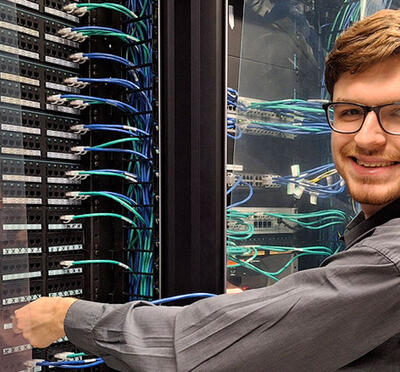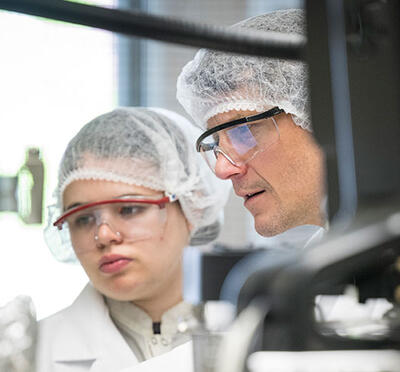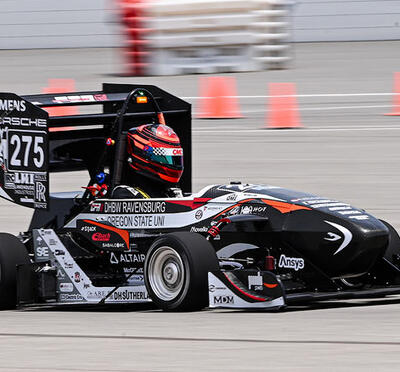Dirk Petersen is fired up and eager to unleash transformative new capabilities for researchers throughout the College of Engineering and other data-intensive disciplines across Oregon State University.
“It’s a very rare and exciting opportunity,” said Petersen, who came on board in December as director of the university’s new supercomputing center. “In the world of research computing, there are not many places where you can come into a relatively new department and help to build it, literally, from the ground up.”
Oregon State broke ground last April for the Jen-Hsun Huang and Lori Mills Huang Collaborative Innovation Complex, which will house the university’s new supercomputer. The complex is on target to open in the second half of 2026. Petersen’s first year of work is already cut out for him, to ensure the supercomputer is up and running on schedule.
Originally from Germany, Petersen earned his degree in business administration and economics from the Wirtschaftsakademie in Kiel. Over the past three decades, he has built his career creating, developing, and implementing strategies, policies, and support for high-performance computing.
Petersen spent more than 17 years at the Fred Hutchinson Cancer Center in Seattle, where he was director of scientific computing. There, he led a department with 11 project managers supporting more than 250 lead researchers. In the midst of the global coronavirus pandemic in 2020, Petersen began to consider his next career move.
“When I sense that my impact is not at its highest anymore, I start looking forward to the next challenge,” he said.
After serving for a few years as director of scientific computing departments at the Moffitt Cancer Center in Florida and Oregon Health & Science University, Petersen was recruited to head up the supercomputing center at Oregon State. He cites the university’s collaborative environment and the opportunity to work with students as key factors in his decision to take the job.
“There is this desire to show your skills, to participate, to make an impact,” he said. “I really get that vibe, and I love that. It isn’t something I have experienced everywhere.”
Immense power to drive research advancements
When the Huang Collaborative Innovation Complex opens in 2026, Oregon State’s new supercomputer is predicted to be among the nation's most powerful at any university. Powered by next-generation NVIDIA CPUs, GPUs, and networking, it will transform the university’s research capabilities in artificial intelligence and other disciplines, Petersen says.
“This increase in power will drive advancements in AI, as well as several critical research areas that increasingly depend on AI – including climate science, clean energy, water resources, quantum computing simulations, and biological system modeling,” he said. “It will provide researchers with the immense processing power needed for large-scale simulations, data analysis, and machine learning tasks. Its advanced architecture will enable faster processing speeds and greater data handling capacity than previous systems.”
The NVIDIA “Rubin” chipset used by the new supercomputer is so advanced, in fact, that it’s not even in production yet. Petersen says it will be a boon to research applications that require vast amounts of computer memory, which is typically a choke point for less powerful systems.
“Not only will it operate at higher speeds than our current computing resources, but it will be able to run many processes simultaneously in parallel,” he said. “But more important, it will have memory large enough to fit scientific problems that cannot be solved by current-generation computing systems.”
Getting everything ready
Petersen’s first-year goals are focused on creating infrastructure for the supercomputing center. This includes setting up new data storage systems, migrating data to a central system, and working with researchers to ensure that their data, code, and personnel are ready for the transition. He emphasizes the importance of preparation, so that the supercomputer can be up and running as quickly as possible.
“Too often it is the case where you buy something and then it takes five months until you can actually use it,” Petersen said. “And that is not what we are planning.”
Taking a wide view, Petersen regards the university’s enhanced computing capabilities within the context of the greater good that can be achieved, in accordance with Oregon State’s mission and strategic plan. He emphasizes that the system should be easily accessible to other institutions in Oregon, including public universities.
“We are working for ‘Prosperity Widely Shared,’” Petersen said of Oregon State’s strategic plan. “But we are still figuring out what that means specifically, or what people think it should mean in practice. Our goal is to have a big impact at Oregon State and beyond, with a focus on sharing the resource as widely as possible.”



